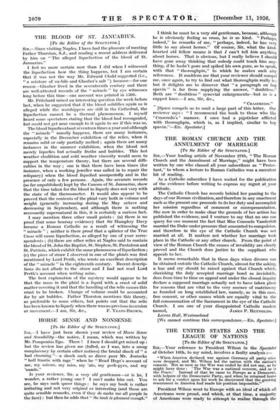THE BLOOD OF ST. JANUARITJS.
[To the Editor of the SPECTATOR.]
Sm,—Since visiting Naples, I have had the pleasure of meeting Father Thurston, S.J., and reading a recent address delivered by him on " The alleged liquefaction of the blood of St. Januarius."
I feel no more certain now than I did when I witnessed the liquefaction how the thing happens, but I am certain that it was not the way Mr. Edward Clodd suggested (i.e., " a mixture of ox-bile and Glauber's salt ") because—for one reason—Glauber lived in the seventeenth century and there are well-attested records of the " miracle " by eye witnesses long before this time—one account was printed in 1506.
Mr. Pritchard raised an interesting question the week before last, when he suggested that if the blood solidifies again as is alleged while the worshippers are still in the Cathedral, the liquefaction cannot be a thermal phenomenon. I myself heard some spectators stating that the blood had recongealed, but could not get near enough to it again to see if this was so.
The blood liquefies about seventeen times a year and although the " miracle " usually happens, there are many instances, especially in the December exhibition of the relics, when it remains solid or only partially melted ; again there are many instances in the summer exhibition, when the blood not merely liquefies but actually froths and bubbles. This hot weather ebullition and cold weather viscosity would seem to support the temperature theory, but there are several diffi- culties in the way ; one is that there have been times (for instance, when a working jeweller was called in to repair the reliquary) when the blood liquefied unexpectedly and in the presence of only a few persons. Again, the accurate records (so far unpublished) kept by the Canons of St. Januarius, show that the time taken for the blood to liquefy does not vary with the state of the thermometer. It would also appear to be proved that the contents of the phial vary both in volume and weight (generally increasing during the May octave and decreasing in September), and although there is nothing necessarily supernatural in this, it is certainly a curious fact.
I may mention three other small points : (a) there is no proof (but some hearsay evidence) that Sir Humphry Davy became a Roman Catholic as a result of witnessing the " miracle " ; neither is there proof that a splinter of the True Cross will cause liquefaction, as alleged by one of your corre- spondents ; (b) there are other relics at Naples said to contain the blood of St. John the Baptist, St. Stephen, St. Pantaleon and St. Patricia, which exhibit the same phenomena of liquefaction ; (c) the piece of straw I observed in one of the phials was first mentioned by Lord Perth, who wrote an excellent description of the " miracle " in the eighteenth century. Recent descrip- tions do not allude to the straw and I had not read Lord Perth's account when writing mine.
The best explanation of the mystery would appear to be that the mass in the phial is a liquid with a crust of solid matter covering it and that the handling of the relic causes this crust to be broken. Change of volume could be accounted for by air bubbles. Father Thurston mentions this theory, as preferable to some others, but points out that the relic has been known to liquefy when there was no previous inversion
or movement.—I am, Sir, &c., F. YEATS-BROWN.














































 Previous page
Previous page